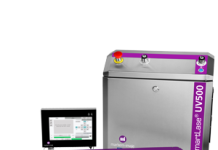It’s all very well identifying a need for digital printing in your operations, but should you be spending money on new machinery, or is choosing the right ink the main priority? For many, the printer carries the highest capital investment and so is the first step, but for others, the printhead drives the decision.
Digital inkjet technologies are taking the global print marketplace by storm, especially as the need for shorter runs of print and personalisation increases. With the digital print market estimated to reach $225 billion globally by 2029, businesses are seeking to implement digital print technology into their operations to achieve productivity and profitability gains – but the real challenge is where to start when considering a new application.
When looking at adopting digital inkjet for the first time in an industrial application, there are several factors to consider:
1. The importance of ink chemistry
Ultimately, the ink itself defines both performance and the acceptance of the print and application, and its chemistry should ideally be a primary consideration in any discussion of digital technology adoption: with everything from ink wetting, adhesion, viscosity and surface tension considered. The choice of ink will also have a significant impact on the drying speed and the overall throughput potential of a system. Although the hardware is, undoubtedly, critical for the delivery of the ink, it is prudent to understand the ink chemistry and match it to the hardware rather than the other way around. If the chemistry is wrong, the ink can affect the application performance, the fastness, the colour and the quality, so getting the choice of ink right is a critical step in the adoption of a digital printing process.
2. Have you chosen the right type of ink?
In markets with evolving regulatory requirements, the ink type itself can be critical as well. For instance, with a growing focus on sustainability, there has been an increased need for water-based solutions that reduce the environmental impact of the print process without compromising quality and consistency. The ink type you choose directly affects the implementation process – for example, by choosing a water-based ink, you are automatically ruling out several hardware options in terms of printhead and system requirements. The type of ink chosen will also dictate the drying or fixation method, and whether the substrate needs to be primed prior to printing.
3. Choosing the best printhead
Advancements in printheads with different nozzle configurations and densities, widths and print frequencies have contributed to increasing the speed, quality and efficiency of the digital print process. In many emerging applications, the print quality and requirements of the head are a primary consideration – for example, high quality packaging markets will require 1200dpi resolution to meet the demands of both the market and brands for text and detail, but the printhead may have limitations when required to print a full tone brand colour. This means that many businesses look at the choice of printhead first and try to match the ink chemistry, software and ink delivery systems afterwards.
4. Is the system integrated?
For many industrial applications, it can be difficult to find an off-the-shelf solution to meet all your technical requirements. In many instances, industrial printers are looking to add digital ink printing capability to an existing production line and, even when an offline printer is acceptable, the full end-to-end process may require something non-standard. For this, system integrators are critical – companies able to use printheads, electronics and software to implement a solution with an existing or custom system are making digital inkjet printing a reality for industrial users globally.
Although digital printing is often seen as the ‘next step’ for industrial printers, it can be a challenging process to implement and ‘starting right’ can often dictate future success. While it’s tempting to consider the printer as the most important factor, the choice of ink chemistry and printhead can often be more critical to success. Ultimately, if the ink does not fit in terms of design, function or substrate, the printer cannot improve the result enough to compensate. An ideal scenario would be to discuss requirements with ink and printhead manufacturers simultaneously, allowing for close collaboration to optimise the performance of the ink – ensuring maximum performance, shorter development time, and ultimately a fully integrated solution.
[sc name=”submit-news” ]
[sc name=”whatsapp_subscribe” ]
SENSIENT INK
https://www.sensientinkjet.com/





















